Ruby Buying Guide
Rubies - The Inextinguishable Fire Within
Ruby is the most valuable variety of corundum, the mineral group to which the gemstone Sapphire also belongs. The 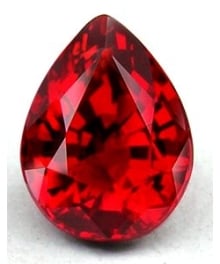 word “Corundum” has derived from the Hindu word Kurand or Kuruvinda whereas the word Ruby originates from Rubrum which is the Latin word for red. Hence, any corundum which is red in colour is called Ruby while any other color is called Sapphire. The marvelous colour ruby is due to the traces of Chromium which also gives emerald its green colour.
word “Corundum” has derived from the Hindu word Kurand or Kuruvinda whereas the word Ruby originates from Rubrum which is the Latin word for red. Hence, any corundum which is red in colour is called Ruby while any other color is called Sapphire. The marvelous colour ruby is due to the traces of Chromium which also gives emerald its green colour.
Ruby is the birthstone of the month of July. It has been coveted as a gemstone since centuries. The legend surrounding ruby goes that the lucky owner of a fine ruby would be assured of a life live in peace and concord with all men, neither his land nor rank would be taken from him and his house and garden would be saved from damage by the tempests.
Rubies are also thought of to be a remedy for hemorrhage and inflammatory diseases. Such stones were believed to confer invulnerability to wounds. Some Burmese people believed that merely wearing the ruby was insufficient and they inserted them in their flesh so as that it becomes a part of the wearer’s body.
What to look for while buying a ruby?
There are numerous factors which govern the price of a ruby such as the colour, the mine from it originates, the transparency, the cutting of the gemstone, absence of colour zoning, presence of silk and the list goes on. For the sake of understanding each of the important factors are covered in detail below.
Colour
The ideal colour for a ruby is a bright traffic signal red colour, a fluorescent red of high intensity. The colour of ruby however can vary from fiery vermilion to violet red, but because rubies are pleochroic, different colours are also found in the same stone. Even rubies with a strong pink, brown or purple tinge are considered rubies but are priced accordingly. There is however a very thin line of differentiation between a ruby of a pale pink colour and a pink sapphire both being the gem variety of corundum. There is considerable difference in opinion of even major Gem laboratories regarding the nomenclature of pink corundum as ruby or pink sapphire. The best colour has been termed as ‘Pigeon’s Blood colour’ but it is of little meaning today as very few people have seen the blood of this Burmese bird.
Unlike diamond, small amounts of silk (strands of mineral Rutile) in the gemstone actually help to scatter the light within the stone. The presence of Iron tends to make the ruby more blackish red (of a dark tone); such colour is found in Thai rubies which also suffer in their colour due to the lack of silk.
Another factor governing the price is the uniformity of colour, the presence of strong zoning diminishes the value in case of ruby. It is due to the concentration of chromium in some areas of the gemstone that gives that particular area a darker colour than the surrounding.
In case of Star Rubies, the presence of silk which forms the star results in the lowering of the colour intensity because the length of light paths through the stone is reduced due to scattering off the silk. A good star ruby should contain only enough silk to form the star but not enough to cause the lightening of the colour. Stones with a good colour but weak star are more expensive than stones with weak colour and a sharp star.
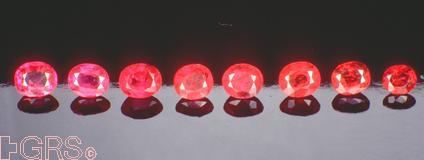
GemResearch SwissLab Master Set for Rubies ranging from pinkish-red to "pigeon's blood" (vivid red) - Adapted from the GRS Website
Transparency
Even more important than colour in rubies is transparency or diaphaneity. A ruby with the best red colour which is opaque will be less valued than a similar sized transparent ruby having purplish colour. Translucent rubies are considered better than opaque material but are still considered commercial quality.
It should be noted that a ruby has a very grim chance of being flawless, unlike diamond which can be free of any inclusions. If your ruby does not have the presence of any inclusion on examination under a hand lens or loupe it is most likely to be synthetic. Also size for size, if a diamond (colorless) and ruby are having the same transparency, the value of ruby will be much more than that of diamond.
Ruby Treatments
The life of the customer would have been much simpler if it were not for the immense number of treatments that are being performed on rubies. In old times, a ruby was merely heated to a high temperature to remove the purplish tinge and make the ruby “redder” in colour. However, with the advances in science, there have been innumerable experiments performed on the rubies with various chemicals and fluxes that have resulted in the existence of several types of heat treatments.
Gemstone dealers and Jewelers usually may tell you that rubies are routinely heated to enhance its colour and transparency; however you MUST ask WHAT TYPE OF TREATMENT has been performed on the ruby, as it has a great effect on the price you are paying. We have developed a chart below on the type of treatments and its value per carat. The one at the top of the list fetches the maximum price while the one at the bottom is least valuable.
1) Natural, Unheated Ruby - The best of all. Completely natural and non-treated, absolutely no enhancement.
2) Heated Ruby - also known as Thermally Enhanced Ruby. Heated without addition of any chemicals– just simple and plain heating.
3) Flux Treated Ruby - Heated with addition of Borax and other fluxes except Beryllium, Lead and Bismuth.
4) Beryllium Treated Ruby - Although this treatment is done primarily on sapphires, it is known to have produced some red colored material which is sold by the name of ruby or red sapphire.
5) Glass Filled Ruby - Heated with chemicals such as Lead and Bismuth which greatly increases the transparency of the stones and is the least valued treatment.
The normal appearance of a Lead Glass Filled Ruby:
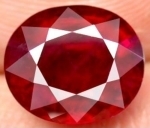
It must be noted that the price decreases multiple times as you go down from Natural Unheated Ruby to Glass Filled Ruby. If we compare two gemstones one of which is a natural ruby and one which is a glass filled ruby of the same quality, the unheated ruby might have a value of thousands of dollars per carat weight while the glass filled ruby will have price of only a few dollars per carat.
Mining Location
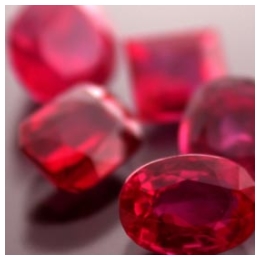 “A ruby of Burmese origin is more expensive than ruby from any other origin”. This statement must have been read or heard by many people from their jewelers, gem-dealers, etc., but the truth of the fact is this is not always so. It is a fact that over the last hundreds of years Burma has been the consistent source of the finest rubies the world has seen, but over the last decade this scenario has changed dramatically with rapid geologic exploration of earlier inaccessible areas, especially Africa.
“A ruby of Burmese origin is more expensive than ruby from any other origin”. This statement must have been read or heard by many people from their jewelers, gem-dealers, etc., but the truth of the fact is this is not always so. It is a fact that over the last hundreds of years Burma has been the consistent source of the finest rubies the world has seen, but over the last decade this scenario has changed dramatically with rapid geologic exploration of earlier inaccessible areas, especially Africa.
Some rubies that exceed the Burmese in quality are Vietnamese rubies which flooded the market in the 1990’s. Very recently, a new mine in Tanzania has been found called Winza which produces exceptionally clean pieces of ruby. On further exploration in the same belt, gem-quality rubies have been found in the Niassa province in Mozambique, many of which are better than Burmese rubies both in terms of clarity and colour. Rubies of exceptional quality are also noted from Kazakhstan, Tajikistan, Afghanistan and Greenland.
In our opinion, the origin of a gemstone should be the last factor to consider when buying a ruby as the quality is what precedes the origin of the stone. Also, the origin should not cause a difference in price more than ten percent in case of similar quality stones.
Cutting of the Ruby
Since ruby is the second hardest natural stone after diamond it takes on a good polish. However, it does undergo abrasion at the edges and hence when buying a ruby, the edges (where facets meet) should be checked for abrasion. An abraded stone is less valuable. A well cut ruby can unleash the fire which the rubies are famous for!
One should also look for chips in the stone’s culet or the girdle which are occasionally left in order to conserve weight. Burmese rubies are especially cut in such a way so as to conserve maximum weight. More often than not, the quality of the cut is compromised to retain the weight of the ruby.
When buying ruby it should be noted that the gemstone should have a good cut with proper proportions and symmetry. A minor defect is acceptable, however it should not be such that the cutting of the gemstone has been completely compromised to retain the weight, and the appearance looks unpleasant.
Synthetics and Simulants
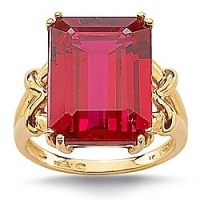 Although synthetics of ruby were first produced for industrial use, primarily in the laser industry, they are now being excessively used in jewellery. Synthetic rubies are those which have the same chemical and physical properties as that of natural rubies but are grown in a laboratory, while simulants are rubies which are just similar in appearance to the natural gemstone but do not have the same chemical & physical properties. With the advent of science, many types of synthetics have flooded the markets which are many a times being passed off as natural rubies. In general, one should always ask specifically about the ruby being natural (and also the type of treatment). Also, since checking of treatments is not possible by an inexperienced customer, it is always advisable to ask for a gem lab certificate to accompany the ruby. If a recognized gem lab certificate is not provided by the dealer, it is advisable to always tell the dealer that you will get the stone certified in a gem lab even if you are not going to do so.
Although synthetics of ruby were first produced for industrial use, primarily in the laser industry, they are now being excessively used in jewellery. Synthetic rubies are those which have the same chemical and physical properties as that of natural rubies but are grown in a laboratory, while simulants are rubies which are just similar in appearance to the natural gemstone but do not have the same chemical & physical properties. With the advent of science, many types of synthetics have flooded the markets which are many a times being passed off as natural rubies. In general, one should always ask specifically about the ruby being natural (and also the type of treatment). Also, since checking of treatments is not possible by an inexperienced customer, it is always advisable to ask for a gem lab certificate to accompany the ruby. If a recognized gem lab certificate is not provided by the dealer, it is advisable to always tell the dealer that you will get the stone certified in a gem lab even if you are not going to do so.
The Various types of Synthetic Rubies are as follows:
1) Geneva Ruby – They were the earliest of the synthetics introduced in 1885 which contained fragments of natural ruby fused together so seamlessly that they would deceive the layman.
2) Verneuil Ruby – In 1891, Verneuil, a French scientist developed a method to produce clean quality synthetics of reasonable size by growing them on a rotating podium with melted aluminium oxide falling on it. Verneuil rubies are produced till date, but they have disadvantage of being limited in their size.
3) Flux-Grown Ruby – Not to be confused with the flux treated rubies, these rubies have been produced by various companies such as Kashan, Ramaura, Chatham, etc. and have been marketed under their name tags. The chemical composition of the flux used to produce these rubies is generally a trade secret.
4) Hydrothermal Ruby – These are rubies which have the most natural appearance as their mode of formation is similar to that in nature. Until now, this process has not been economical to produce rubies on a mass scale.
5) Czockralski-Pulled Ruby – This is a type of synthetic in which the ruby crystal is pulled out from the melt, hence it attains larger sizes than that produced by Verneuil method.
The various types of Ruby Simulants are numerous, but mostly they are Almandine/Pyrope Garnet, Rubellite Tourmaline, Spinel, Glass, Doublets with top part of garnet and lower part of red glass. Synthetic Spinel has also in many cases been used to imitate ruby.
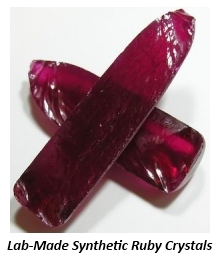
Lighting Conditions
Another factor which greatly influences the appearance of a ruby is the lighting conditions under which it is seen. The best lighting conditions to look at a ruby is daylight, since it has a more balanced spectrum. Cool white light (Tube lights) can cause the appearance to be more purplish than red while incandescent light (Bulb light) can make the ruby more red than it is actually. A compact fluorescent light balanced at 5000K which imitates natural daylight is ideal in case of absence of sunlight. A better approach is to see the gemstone in all types of lighting and then make your decision about the purchase.
In conjunction to all these factors listed above, the most important factor is that the ruby MUST look good to your eye and should be able to capture anyone’s attention..

A 3.03-Carat Unheated Ruby from our inventory mounted in an elegant 14K White Gold Ring
Interested in Buying Rubies? We deal in only Unheated / Untreated Rubies, and all stones come with gem-lab certification. Here are the links to the categories listing rubies:
Burmese Rubies | Vietnamese Rubies | Tajikistan Rubies | Madagascar Rubies | Mozambique Rubies | Winza Rubies | West African Rubies | Thai Rubies | Indian Rubies | Ruby Cabochons | Star Rubies










